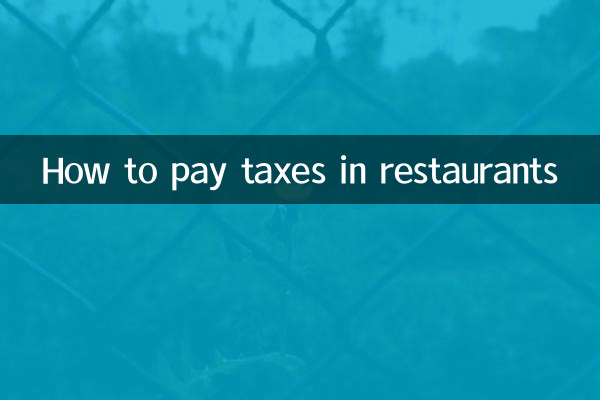How to pay taxes in restaurants: A comprehensive analysis of tax policies and practical guide
Recently, tax issues in the catering industry have become a hot topic, especially new restaurants are confused about tax treatment. This article will combine the hot content of the entire network for the past 10 days to provide catering operators with clear tax guidelines, including structured data such as tax types, tax rates, and declaration processes to help you operate in compliance.
1. Main taxes involved in restaurants

| Tax types | Tax rate/standard | Collection method |
|---|---|---|
| VAT | Small-scale taxpayers: 3% (currently reduced by 1%); general taxpayers: 6% | Monthly/quartly declaration |
| Corporate Income Tax | Small and micro enterprises: 5%-20%; standard tax rate: 25% | Prepayment on a quarterly basis, annual reconciliation |
| Urban maintenance and construction tax | 7% of the VAT (urban area) | VAT levy |
| Personal Income Tax | 3%-45% (employee salary); 20% (self-employed) | Deduct or declare monthly |
2. Analysis of hot issues
1.Tax benefits for small-scale taxpayers: The latest policy in 2023 shows that small-scale taxpayers with monthly sales of less than 100,000 yuan are exempt from value-added tax. The policy continues to the end of 2027 and is the focus of attention of the catering industry in recent times.
2.Difference in tax rates for takeout and dine-in: According to the tax department's clearance, catering and restaurant takeaway business pays value-added tax (general taxpayers) at a 6% tax rate of "catering services", which is in sharp contrast with 1% of small-scale taxpayers. It is necessary to pay attention to the distinction.
3.Electronic invoice promotion: Taxation departments in many places across the country have recently strengthened the promotion of electronic invoices, and restaurants need to timely open tax UKeys to complete the upgrade of the invoice system.
| Business scenarios | Key points for tax-related treatment |
|---|---|
| Ingredients Purchase | Request a special VAT invoice (deductible by general taxpayers) |
| Join the business | Brand usage fees must be paid value-added tax based on the "Rule usage fee" |
| Promotions | "Buy one free one" needs to be shared and confirmed by fair value |
3. Application process and time nodes
1.VAT filing: Small-scale taxpayers shall declare quarterly (before January 4/7/October 15), and general taxpayers shall declare monthly (before January 15th of the next month).
2.Corporate Income Tax: The advance payment declaration is within 15 days after the end of the quarter, and the annual settlement and settlement shall be before May 31 of the following year.
3.Personal tax return: Employee salary personal income tax must be declared through the "Natural Person Electronic Taxation Bureau" before the 15th of the next month.
4. Tax optimization suggestions
1.Reasonable choice of taxpayer status: Restaurants with annual sales of less than RMB 5 million can choose small-scale taxpayers and enjoy low tax rates.
2.Standardize cost notes management: Expenditures such as food procurement, rent, water and electricity should obtain compliant invoices to reduce taxable income.
3.Take advantage of regional tax benefits: Some development zones have tax refund policies for the catering industry, and they can be given priority when selecting a site.
Conclusion: Catering tax management requires operators to continue to pay attention to policy changes. It is recommended to log in to the Electronic Taxation Bureau regularly to view the latest notices, or entrust a professional accounting agency to handle tax matters, so as to ensure that you can enjoy policy dividends while operating in compliance.
(Note: The data in the article is as of October 2023, and the specific implementation shall be subject to the requirements of the local tax authorities)

check the details

check the details